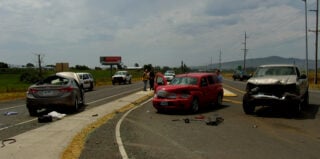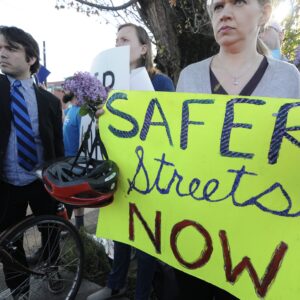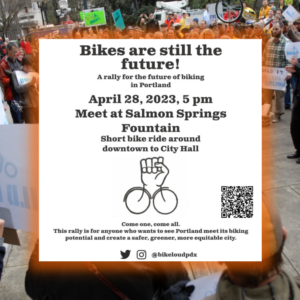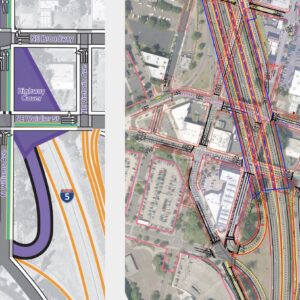As long as roadway fatalities and injuries keep piling up, local activists plan to keep protesting.
Fresh of last week’s rally and demonstrations at City Hall, volunteers with BikeLoudPDX will continue their actions with a Death Toll Memorial event tomorrow at the headquarters of the Oregon Department of Transportation in downtown Portland.
“Several of us feel the need to publicly acknowledge that 30 people lost their lives in June on Oregon roads in preventable wrecks,” wrote event organizer Dan Kaufman. Kaufman, the same man who organized the protest on SE Powell Blvd back in May, is fed up with the loss of life and injury on our roads.
Fueling Kaufman’s outrage is an alarming uptick in Oregon traffic deaths. According to ODOT, from January 1st through June 23rd there have been 194 fatalities on Oregon roads. That’s an increase of 39.6 percent over the same time-frame last year. (And since the 23rd there have been at least six more fatalities (according to our research) bringing the total up to 199.)
Advertisement
While the state agency is working on various safety measures, some activists feel ODOT should do more as well as re-think their priorities. “They, and many in the state legislature, want to expand freeways while ignoring the carnage,” Kaufman says.
Last week ODOT and the legislature tried (unsuccessfully) to push through a transportation bill that included over $70 million in earmarks for highway widening projects. In a notice about an upcoming project in Washington County, ODOT claimed that widening Highway 26 with a new lane in each direction would, “improve traffic safety and relieve congestion.”
In contrast, the description for tomorrow’s event reads: “The current transportation priority is expanding our dysfunctional road system… We will not support any roadway expansion until Vision Zero is adopted and implemented statewide.”
Unlike the City of Portland, who officially adopted Vision Zero earlier this month, ODOT has yet to embrace the concept. Speaking at an event back in April, ODOT’s Traffic Safety Division manager Troy Costales said their goal is to “increase the number of zero fatality days.”
BikeLoudPDX plans to make this a monthly event that will draw attention to the ongoing death toll. They’re hoping to tell stories from the perspective of the deceased and have family members of the victims show up and speak.
The event is at 4:30 to 5:30 pm tomorrow (6/30) at ODOT Region 1 headquarters (123 NW Flanders). Learn more via Facebook.
Stay tuned for more coverage of ODOT’s traffic safety efforts. We are working on an interview with Costales to find out more about this year’s uptick in fatalities and what he’s doing to address the issue.








Thanks for reading.
BikePortland has served this community with independent community journalism since 2005. We rely on subscriptions from readers like you to survive. Your financial support is vital in keeping this valuable resource alive and well.
Please subscribe today to strengthen and expand our work.
If I knew I could get it delivered, I’d order a cake that says “CONGRATS ON YOUR 200th DEATH!”.
So…cake *and* death, then? I was under the impression one had to choose.
Kudos.
The biggest reason for the uptick in traffic accidents is inattentive drivers (texting, talking on cells phones, eating hamburgers, putting on makeup, etc., etc.). Something ODOT has no control over. But the cops do, if they would just do it.
If we need to change the rules to account for driver inattentiveness or start giving out harsher punishments in order to get drivers to pay attention, we should be doing this. Perhaps one of the ways to start is day-fines
They could stop building roads that drivers are comfortable being inattentive on.
You can’t make anything fool proof because fools are so ingenious.
Right, so why try? /s
“Something ODOT has no control over.”
I disagree, ODOT has more control with traffic calming measures built into infrastructure that would work 24/7 over the seemingly random and inconsistent traffic enforcement.
Traffic calming measures like speed reduction, narrowing of lanes or road diets, chicanes/diverters, limiting access of drivers etc, etc all create immediate safety effects. Whereas traffic enforcement only works when police are present.
I agree. Sweden’s version of ODOT were the folks who came up with the original concept for Vision Zero. Passing the buck isn’t going to get us anywhere. ODOT is (in principle) very well positioned to support Vision Zero, to throw their weight behind it, to advocate for changes across the board that would involve shrinking some of the unfettered privileges and prioritization motorists now enjoy (thanks in no small part to how ODOT sees its mission), as well as delivering greater safety.
Speed limits,
Road design,
Enforcement,
Funding parity for nonmotorized modes,
etc.
Right now we just keep getting boys will be boys language from them when someone in a car kills someone riding a bike. This is not good enough. Not by a long shot.
http://bikeportland.org/2014/09/20/san-diego-bike-coalition-board-member-critical-condition-rear-end-collision-111212#comment-5529362
actually, the only ones who really have control are the individual motorists.
Just as a thought experiment (not an actual suggestion), imagine if ODOT could reduce the speed limit to 10MPH on all roads, including sufficient road design and enforcement to ensure compliance. In that case road deaths go to zero, or near zero, despite inattentive drivers. You’d need to be something other than inattentive — say, murderously reckless — to kill someone under those conditions.
That’s obviously extreme and not what I consider a realistic alternative but it does show that in principle ODOT has some control separate from that of individual motorists. With improved road design and targeted or increased enforcement we can make accidents less likely and/or less serious without simply punting hopelessly to an amorphous mass of “individuals.”
It’s not as hopeless as you make out. 🙂
Nice!
Cf. Ivan Illich’s proposal for a universal 15mph speed limit (different motivations, but salutary all the same).
This is the part that bugs me the most, by far: the defeatist attitude and the excuses offered up that don’t pass muster. “There’s nothing that can be done,” “Road design won’t eliminate all deaths,” “We don’t have the money.”
Horsepucky! We have enough money to change out every speed sign, and lowering speeds to 15-20 would virtually eliminate traffic deaths.
It’s not necessarily realistic as Paul pointed out, but the proof of concept is there: we do have the physical ability to solve this particular public health crisis, all we need is the right people working at the DOT.
It’s incredible how little enforcement there is. The one memorable time I saw a cop on my bike commute was when he had pulled over a *cyclist*. And there’s those famous Ladd Circle stings. I think you’re pretty much free to break traffic laws in this town if you’re in a car.
“The stretch of the Sunset Highway has reached its vehicle capacity. Traffic demands will increase as the population and employment in Washington County continue to grow and without improvements, congestion and crashes are expected to increase.”
Stated as fact!
Wow, way to go.
So let’s widen the highway, induce even more traffic and maximize carnage.
The only thing that will help reduce death on our roads is the collective acceptance that we must engineer roads to accommodate human error, and still keep us safe. We must build infrastructure to allow errors without death resulting.
“Increase the number of zero fatality days”??? You can have 364 zero fatality days and if 300 people die on the 365th day you’ve still met your goal. ODOT needs a lesson in creating goals that address the real metrics, i.e. saving people’s lives.
ODOT certainly has control over the facilities. Hwy 99 has been repaved from Hwy 18 to Dayton, and the previously crummy but existing shoulder now narrows to about 8 inches in places. Inexcusable.
Here is something more people can do if they want to get ODOT to adopt Vision Zero: https://btaoregon.org/2015/06/action-alert-move-oregon-to-vision-zero-urge-legislators-to-pass-hb-2736-a/
Do it folks — quit staring at the BikePortland screen and switch to that BTA window and let your elected officials know you care. It’s too easy to be a blog rat in this comfy little self-reinforcing world of BikePortland.org and hope that sage postings here will result in action elsewhere. Get out of your comfort zone. Be a force of change!
Ted Buehler
Does anyone else ever note the rather nice speedbumps on NW Lovejoy from 36th on up the hill past the tunnels? They are fantastic and major kudos to ODOT or PDOT or whoever put them in. They have garden pots in the middle of the road to help seperate the lanes, they are marked on the pavement like crosswalks, they have a 4-6 inch cut in the middle of each lane for bikes or motorcycles to go through without going airborne. If the street is to be 20 mph for instance, make the bumps about 5-6 inches. This is high enough so if a motorized vehicle hits them over 20-25 mph It could do some major damage to the vehicle. Guaranteed if someone did this consistantly the vehicle would be ready for the wrecking yard in a couple of weeks. Rednecked sports cars, 4Wd big wheels. would have drivers going through their sunroofs by the time they went over a few.
These would be ideal for NE Going street project.
Keep the pressure on, people. It seems like we’re just starting to get some attention to making the streets safer. Soon we’ll see momentum in the right direction. Don’t get discouraged! Don’t get frustrated! Don’t give up!
I recall reading the ODOT manual on the setting of speed limits a few years ago. It said that ODOT operates under the (false) assumption that motorists tend to drive at a safe speed, thus they set the speed limit based on the speed that people drive.
Our constant CARnage on the road puts the lie to that statement, as well as any unbiased observation. Just how many pedestrians stand waiting for minutes at a time because the motorists are driving too fast to stop at the cross walks (or the pedestrians rightfully fear that this is the case)? How many people won’t ride bikes because of a fear of speeding motorists?
ODOT operates in an alternate reality.
Someone correct me if I’m wrong, but don’t we have fewer state troopers on the road now than we did in the ’70s? I know we have fewer deputies in our non-urban counties. I really think that enforcement is the key to roadway safety, but it’s tough to do enforcement without employing officers to do it.
Also, a few years back our governor tried to fund the troopers out of the road budget and was slammed for his attempt. It seems the entitled car-addicts don’t want any of the money we spend on roads diverted to law enforcement; no surprise since none of them seem capable of obeying the laws, or even knowing them.
Garshdangit! Wish I could be there tomorrow. Okay, maybe next month.
Best of luck! (And by that I mean, “best of luck getting there if you have to use an ODOT facility.”)
The people of Oregon should file a Class-action lawsuit against ODOT. Anybody who operated a vehicle or otherwise used an ODOT facility was put at risk by their willful negligence, and would have standing. Those injured or who lost relatives from crashes would have extra standing, and would collect more in damages. Naturally, there would be a negotiation period where a deal could be struck: in lieu of damages, ODOT would publicly renounce their outdated and disproven policies, and commit to an inclusive Vision Zero plan, supervised or approved by a reputable agency. If they fail to meet incremental goals, they would be fined, and officials would be replaced until they complied.
This department is reckless with the lives of its bosses, the citizens of Oregon, and drastic action must be taken. Enough is enough. Not one more death.
I like this idea… sign me up… lawsuits seem to get people’s attention, even if they’re not won…
The overhead freeway signs in Chicago list the number of fatalities to date in the State of Illinois. This afternoon (Monday, June 29) the tally was 414 fatalities so far in Illinois for 2015. Illinois’ population is just under 13 million; Oregon’s is almost 4 million. That means Oregon’s fatality rate is considerably worse than that in Illinois. That’s disheartening!
I don’t want to think about what ODOT’s signs would say….
“Number of hours since our last fatality.”
< voice=”Rockem Sockem Robots” > His block is knocked off! < /voice >
If we really want to get the word about this out, we need to share our thoughts on this beyond this website. Here, we are often preaching to the choir. I am going to start getting the news out to people who don’t cycle by posting to Facebook and other social media. If we can start getting the larger community involved, maybe we can see greater change. Because let’s face it, the Oregonian is not going to publish this in such a way to get people to demand safer roads.
“Here, we are often preaching to the choir.”
I think this phrase is over- and misused here.
Talking amongst ourselves is not the same thing as preaching to the choir. I don’t know at the beginning of the day what specific insights I might learn today by reading bikeportland stories and comments, but I can generally count on there being a few tasty morsels.
Any citations to the idea that its because of distracted driving? I mean, yes, that does not help, but why would you see such a sudden spike?
Since hwy 26 was mentioned… closer in, the right lane to continue east on 26 through the tunnel is always backed up (noon, night, I don’t think I’ve ever seen it flow) is it just because of the turn and short tunnel? I’ve always wondered if that was one spot where widening the road might actually help (and its already closed to bikes).
I think there’s a few problems with that idea, but I’m no traffic engineer. First, we find that traffic slows because people are jockeying for lane position before they are “not allowed” to change lanes (not that it stops them) once they near the tunnel. Secondly, traffic speeds must slow through the tunnel because it’s narrow, steep and curvy. Also, the cost of expanding the tunnel itself to accommodate an additional lane would be huge. Even though most traffic does continue on to I-5, I don’t think adding that very expensive lane would really help prevent traffic from slowing down. This is 26’s primary bottleneck, and I don’t really understand how adding lanes before there will help travel times either..
They want to widen Hwy 26 further west to make it easier for Intel folks to drive to work. They also want to widen West Union to 4 lanes, and keep the speeds of all arterials high. I’m sure there are other widening plans to go along with those.
The majority of the Washington County commissioners are bent on improving conditions for large businesses and housing developers. If you are not a large business or a housing developer, GOOD LUCK.
the right lane of 26 east through the tunnel is often clear at non-commute times…
it’d be a lot more clear if people obeyed the law and stopped causing their own traffic jams…
stop tailgaiting and creating the domino braking effect (manual transmission helps against this)…
stop illegally changing lanes where the double-lines are and cutting in front of people and causing a domino effect when everybody slams on their brakes because of you…
traffic isn’t caused by “other” drivers, it’s caused by people abusing the system…
Traffic deaths are declining nation-wide:
http://www-nrd.nhtsa.dot.gov/Pubs/811552.pdf
BUT deaths from distracted driving have increased in past 10 years or so:
http://www.ncbi.nlm.nih.gov/pmc/articles/PMC2951952/
pedestrian and cycling deaths have increased as well.
Oregon, like all states and the US on average, has had a slow and steady decrease in auto related fatalities over the last several decades. I would not expect 2014 to be a reversed trend, but a blip in a longer standing trend. At around 8 deaths per 100,000 residents per year, Oregon is actually safer than many states AND could be much safer.
To keep that trend continuing toward Vision Zero, Oregon (and other states), have to be persistent on all things related to crashes (not necessarily in this order):
1. Lowering speed (both legal limits and illegal speeding)
2.Drunk Driving – harsher sentences and suspensions and more frequent checks.
3. Making it harder to get a license and maintain it.
4. Decreasing conflict between bikes/peds and cars.
I really think enforcement can change behavior. Maybe not for every single driver, but for a majority, which will slow down many others.
About 6 months ago my spouse received a speeding ticket on Johnson Creek (a 25mph street) in Milwaukie from a speeding camera. It was deserved. Since then we drive the speed limit on that road All The Time (which, I must say, takes concentration, because it’s designed for higher speeds). Just last week I had an extremely frustrated tailgater behind me who wanted so badly to pass me (over the double yellow line). But the threat of another ticket kept us at 25, even when facing extreme social pressure the other way from the car behind us.
Agree. I see a lot of reflexive “that won’t work” arguments (here and elsewhere), and I want to ask, “Well? Will it work on you? If so, are you so different from everyone else? Or are you saying that you personally will always disregard the chance of getting an expensive ticket, and you think everyone is just like you?”
When I had a car, I was paranoid about speed enforcement. I never got a ticket, but I passed some of those automatic displays a few times and was reminded to slow way down – then, and for the rest of my trip.
By the same token, a cop once pulled me over on a side street in Irvington (on my bike) to have words with me because I’d failed to stop at a stop sign a few blocks back. I’ve been a much more stop-sign compliant rider ever since.
Enforcement works, on a lot of people a lot of the time. It’s worth doing.
Best traffic / speeding / reckless driving calming measure: enforcement and awareness of strict enforcement.
Hence our frustration at being unable to get enforcement of Bethany BLVD’s 35mph zone. Sheriff tells us, ‘if we start pulling people over for doing less than 50mph, we’ll be pulling over everyone. Sure, for a little while. But then word will get around….
end quote after ‘everyone’.
Same boat everywhere. Pulling over two cars an hour will slow everyone down. It’s a lame excuse.
Focusing all the attention on ODOT is shortsighted in my opinion. A successful transportation network requires a balance of engineering, enforcement, education, encouragement, etc. ODOT can build a near-perfect highway but if it lacks enforcement and an educated populace (don’t text and drive!) then what has been accomplished?
In the end ODOT is taking its directive from the legislature and the governor, balancing mobility needs of freight to keep the economy vibrant vs. multimodal needs of the general public. Protesting the rise in statewide fatalities to ODOT staff at Region 1 will only go so far. If you want to make a fundamental change, organize a protest on the front steps of the Capitol Building and contact your representative.
Cheers
“In the end ODOT is taking its directive from the legislature and the governor”
I’d love to hear from someone if that is really true? Because until we know this it sounds like buck passing to me. Matt Garrett isn’t just a mouthpiece for the governor. He has to have all sorts of discretion to run the agency in a manner that meets the needs of everyone or just keeps the Cold War CARS thing going. Besides, I would think turning this into a conversation about *safety* would provide a way around this defeatist always blaming someone else attitude.
“A successful transportation network requires a balance of engineering, enforcement, education, encouragement, etc. ODOT can build a near-perfect highway but if it lacks enforcement and an educated populace (don’t text and drive!) then what has been accomplished?”
Um, ODOT has staff that, for instance, write (awful, sing-song) pamphlets that address behaviors by traffic participants of various stripes. They are not all engineers over there. I think you may underestimate their sweeping role in all of this. As for enforcement, I don’t think anyone has decreed that ODOT can’t at these kinds of meetings, or anytime really, champion safety and/or stump for more or a different emphasis within the realm of enforcement. They stumped for the CRC for years; who says they can’t stump for something that would actually be useful to their constituents?
Harla, I think you’ve overestimated the maturity, scope, and resources of our movement. BikeLoudPDX is less than a year old. Our target choice “methodology” includes convenience (Salem is not convenient for a Portland-based movement!) and media attention as well as who makes the biggest, most powerful decisions.
Someday, yes, a State Capitol campaign will be in the works. But before that we need legal incorporation, money, organization, greater numbers, research into which legislators need to be pressured on what, ideally a political contribution and on-the-ground campaign arm so we have “carrots” and “sticks” for legislators, and I’m sure other things I’m forgetting. Please join us (your choice of electronic engagement available at bikeloudpdx.org ) if you want to see this come to fruition!
> Troy Costales said their goal is to “increase the number of zero fatality days.”
ODOT might as well say that they hope Thursdays are “death free days” but they’re OK with folks dying on Fridays.
I’m not sure how many hundreds of times I’ll have to say it but ODOT doesn’t really care about traffic deaths. Sure they’ll write flowery press-releases and vision statements about reducing traffic deaths and making roads safer but then they go back to building wider and more roads to get more people in cars. And they don’t pressure communities to stop clogging roads up with auto-centric development that destroys any efficiency that might have been gained.
ODOT needs to go back to their old name so there’s no confusion that their mission, especially outside of Portland, is to build highways no matter what the environment.